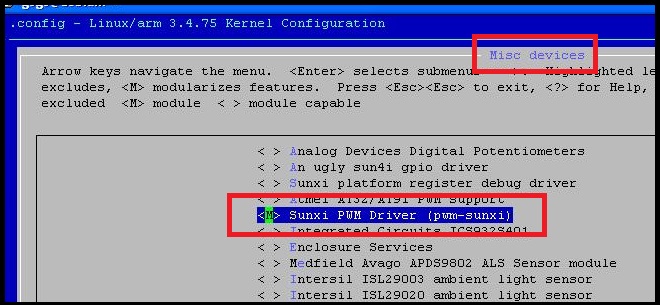How to add pwm
How to enable PWM libraries for Olimex Allwinner boards
The article describes how to enable the PWM control in the Olimex Allwinner boards under Linux by enabling the "Sunxi PWM Driver" in the kernel.
If the Linux PWM module in the board you are using is not available for use there is a good chance it is not enabled by default in the distribution you are using. A way to enable it is detailed below.
To enable the PWM module you need to perform five major steps:
1. Recompile the kernel following one of the Olimex wordpress guides for the board you have on how to do it. The only difference would be to enable the "Sunxi PWM Driver (pwm-sunxi)" as shown in the picture below.
2. Replace the uImage file from first partition of your SD card with the generated one from ../linux-sunxi/arch/arm/boot/uImage directory
3. Replace the modules from second partition of your SD card (usualy they are located in /lib/modules/xx.xx.x) with the new generated modules from ../linux-sunxi/out/modules/xx.xx.x
if the PWM module is not loaded you can load it with
#modprobe pwm-sunxi
4. Edit the script.fex in the "[pwm0_para]" paragraph adding PWM support for specific pin.
Example config for script.bin:
[pwm0_para]
pwm_used = 1
pwm_period = 10000
pwm_duty_percent = 100
Source and more info on the subject: google sunxi groups discussion on pwm0_para
5. Boot the board and use the library! Info on the pwm class:
- /sys/class/pwm-sunxi
|
+----pwmX
|
+---duty
+---duty_percent
+---period
+---polarity
+---pulse
+---pin
+---run
Information on the parameters:
period (r/w) - period that makes up a cycle. Can be expressed as hz, khz, ms, or us. Whole numbers only.
Examples:
echo 10hz > /sys/class/pwm-sunxi/pwm0/period
echo 1khz > /sys/class/pwm-sunxi/pwm0/period
echo 100ms > /sys/class/pwm-sunxi/pwm0/period
echo 100us > /sys/class/pwm-sunxi/pwm0/period
echo 150khz > /sys/class/pwm-sunxi/pwm0/period
duty (r/w) - portion of the period above that is "active" or on. Same units as above.
Examples:
echo 1hz > /sys/class/pwm-sunxi/pwm0/period
echo 2hz > /sys/class/pwm-sunxi/pwm0/duty
duty_percent (r/w) - duty (above) expressed as a percentage. Whole numbers only.
Example:
echo 50 > /sys/class/pwm-sunxi/pwm0/duty_percent
polarity(r/w) - polarity of the pin during the duty portion. 1 = high, 0 = low
pulse (r/w) - output one pulse at the specified period and duty
pin (ro) - returns the name of the pin this pwm outputs on. This is hardwired and informational only (the pin for PWM0 is PB2 and the pin for PWM1 is PI3). If you have a display connected it is advisable to use PWM1 (PI3). That is because PWM0's signal PB2 is used for the LCD connection.
Examples:
cat /sys/class/pwm-sunxi/pwm0/pin
nano /sys/class/pwm-sunxi/pwm1/pin
run (r/w) - Enable the PWM with the previously set parameters. Example:
Example:
echo 1 > /sys/class/pwm-sunxi/pwm0/run
echo 0 > /sys/class/pwm-sunxi/pwm0/run
Source and more info on the subject: google sunxi group discussion on PWM kernel module



